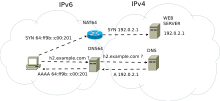- NAT64
-
IPv6 transition
mechanismsStandards Track Experimental Informational - IVI
- TRT
Drafts - 4rd
- AYIYA
- dIVI
Deprecated v · IPv6 hosts to communicate with IPv4 servers. The NAT64 server is the endpoint for at least one IPv4 address and an IPv6 network segment of 32-bits (for instance 64:ff9b::/96, see RFC 6052, RFC 6146). The IPv6 client embeds the IPv4 address it wishes to communicate with using these bits, and sends its packets to the resulting address. The NAT64 server then creates a NAT-mapping between the IPv6 and the IPv4 address, allowing them to communicate.[1]Principle of operation
Very simplistic NAT64 setup can be thought as a network device (a router) with at least two interfaces. One of this interfaces is connected to IPv4 network, and another is connected to IPv6 network. The network configured in a way that packets from IPv6 network to the IPv4 network get routed through this router. The router itself performs all the necessary translations needed to transfer packets from IPv6 network into the IPv4 network, and vice versa.
The translation isn't symmetric, as IPv6 address space is a lot larger than IPv4 address space (compare: 2128 for IPv6 and 232 for IPv4), so no one-to-one address mapping is possible. Therefore, in order to be able to perform the translation, NAT64 is required to keep the IPv6 to IPv4 address mapping (that is, it's stateful). Such an address mapping is either statically configured by the system administrator, or (more frequently) is created automatically when the first packet from IPv6 network reaches NAT64 to be translated. After this address binding is created, packets can flow in both directions.
In general, NAT64 is designed to be used when the communications are initiated by IPv6 hosts. Some mechanisms (including static address mapping) exist to allow the reverse.
References
- ^ RFC 6146 Stateful NAT64: Network Address and Protocol Translation from IPv6 Clients to IPv4 Servers
v · Internet Protocol Version 6 General - IPv6
- IPv6 address
- IPv6 packet
- Mobile IPv6
Deployment IPv4 to IPv6 topics Related protocols Categories:- IPv6
- Routing software
- IPv6 transition technologies
Wikimedia Foundation. 2010.
Look at other dictionaries:
NAT64 — and DNS64. NAT64 es un mecanismo que permite a hosts IPv6 comunicarse con servidores IPv4. El servidor NAT64 dispone de al menos una dirección IPv4 y un segmento de red IPv6 de 32 bits (por ejemplo 64:ff9b::/96, véase RFC 6052, RFC 6146 … Wikipedia Español
IPv6 transition mechanisms — Standards Track 4in6 6in4 6over4 DS Lite … Wikipedia
Transition d'IPv4 vers IPv6 — Pour consulter un article plus général, voir : IPv6. La transition d IPv4 vers IPv6 est un processus qui vise au remplacement progressif du protocole IPv4 par IPv6 sur Internet. Sommaire 1 Phases de la transition 2 Transition pour des hôtes… … Wikipédia en Français
Mecanismos de transición IPv6 — Los mecanismos de transición a IPv6 son las tecnologías que facilitan y facilitarán la transición de Internet de su infraestructura IPv4 al sistema de direccionamiento de nueva generación IPv6. Concretamente, hay métodos que permitirán a hosts… … Wikipedia Español
Исчерпание IPv4-адресов — Динамика количества свободных блоков /8 с 1995 года Исчерпание IPv4 адресов истощение запаса нераспределённых адресов протокола IPv4. Адресное пространство глобально управляется американской некоммерческой организацией … Википедия
dIVI Translation — dIVI PD … Wikipedia
IPv6 — Internet protocol suite Application layer BGP DHCP DNS FTP … Wikipedia
DirectAccess — is a new feature in Windows 7 (Ultimate and Enterprise editions only) and Windows Server 2008 R2 that provides seamless intranet connectivity to DirectAccess client computers when they are connected to the Internet. Unlike most traditional VPN… … Wikipedia
DirectAccess — является новым компонентом в операционных системах Windows 7 Ultimate, Windows 7 Enterprise, Windows Server 2008 R2, который позволяет подключаться клиентским компьютерам к серверам DirectAccess, сразу как только появляется возможность выхода в… … Википедия
Microsoft Forefront Unified Access Gateway — Unified Access Gateway Original author(s) Microsoft corporation … Wikipedia
Share the article and excerpts
Direct link
https://en-academic.com/dic.nsf/enwiki/11786310 Do a right-click on the link above
and select “Copy Link”

